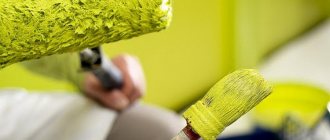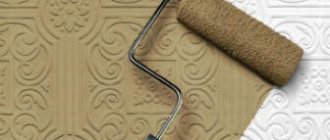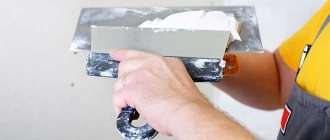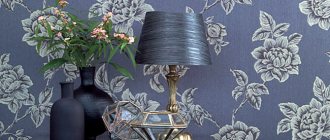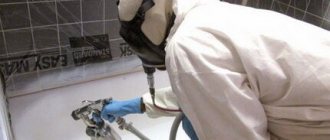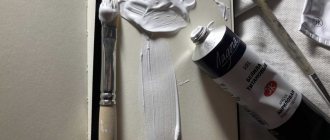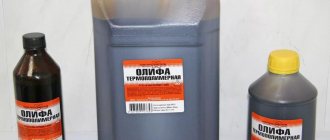Today, the finishing materials market offers a wide variety of paints and varnishes. As reviews on forums, photos in catalogs and videos on online construction resources show, alkyd and acrylic paints are especially popular. So what's the difference and which is better? To find the answer, you need to understand in detail the features of their composition, application and properties.
Compound
In fact, the only similarity is that they are both paints. They are completely different in composition.
The alkyd type can be called a more modernized version of oil paints. They are characterized by a similar mechanism for the formation of clots and surface films (which, by the way, is slightly stronger, but less flexible). Alkyd paints consist of polyhydric alcohols (such as glycerin) combined with orthophthalic acid. In fact, the word "alkyd" comes from a combination of the words "alcohol" (alcohol) and "acid" (acid).
In contrast, acrylic alkyd paints are based on acrylic, a polymer more commonly known as plexiglass. The paint composition may contain various additional ingredients to improve certain properties (increase flexibility, speed up drying).
Basic properties
- Life In acrylic paint, unlike alkyd surfaces, it retains its original appearance much longer. It is recommended to renew alkyd paint about once a year, since oxygen and ultraviolet radiation intensively damage the top layer of paint. Acrylic coating, subject to surface preparation technology and paint application, can be used from 8 years (wood) to 20 years (plaster).
- Resistant to ultraviolet radiation. Acrylic practically does not change the properties of the surface film when exposed to sunlight, that is, it does not fade, turn yellow or take on a “matte” appearance. Alkyd compounds are not as reliable in this regard.
- Drying process. But the alkyd film dries relatively quickly and after a few days completely fulfills its protective and decorative functions. Acrylic foil ends approximately a month after application to the surface. In this case, the coating must be protected from mechanical stress until completely dry.
- Mechanical stability. The longer process of forming an acrylic film is compensated by a higher level of resistance to mechanical stress (deformation, scratches).
- Decorative properties. Alkyd preparations offer a more varied range of shades and shades, as well as more overall, brighter colors. On the other hand, acrylic paint lasts longer and does not require regular updates.
Are acrylic and alkyd paints compatible?
Can I use alkyd compounds on acrylic or vice versa? Neither is recommended, especially if the substrate has been painted relatively recently or is a metal surface. The fact is that the specific composition of the paint may not be entirely clear to us. Alkyd preparations may contain ingredients that appear through the dark spots of the acrylic paint. If alkyd paint is applied to the top of the acrylic, it may not stick to it, meaning it will come off.
The only way to apply such paints to each other is to apply it to an old coating from which all the volatile components have evaporated. However, even in this case, the top coat of paint should only be applied after the surface has been treated with a similar type of primer (i.e. acrylic paint on acrylic primer and vice versa).
Consumers are often interested in the question: which paint is better - alkyd or acrylic enamel and what is their difference. To answer these questions, you need to familiarize yourself with the purpose of each option, their differences in composition, as well as positive and negative characteristics.
Differences in key indicators
To understand how one coloring agent differs from another, you should pay attention to the composition of these paints. The similarity lies only in their versatility in relation to the surface being processed. There are much more differences between them:
- The service life of these two types of paint differs greatly. Alkyd needs to be renewed every year, while acrylic can last from 8 to 20 years.
- Acrylic is not subject to change, while alkyd enamel fades, turns yellow and becomes matte when exposed to the sun.
- The palette of alkyd paints is much wider than acrylic ones.
- A composition containing acrylic is less susceptible to mechanical stress, so it does not crack and maintains its integrity.
Purpose and application
Alkyd enamel has universal properties and is used to treat different surfaces. It is often used for painting wood and metal.
Car enamels with this composition are used to paint and protect the surface of the car. This coating prevents rust.
The paint is applied in several layers. If work is carried out indoors, care must be taken to ensure ventilation. Respiratory protection equipment (eg respirator) is required.
Acrylic enamel is no less versatile in terms of choice of material, but is more often used for painting metal after it has been treated with a primer. Thanks to the paint, the treated surface gains protection from the negative effects of moisture and pests.
Acrylic can withstand high temperatures, so this coloring agent is often used for heating elements of a car and heating radiators.
Flow rates per 1 m
Of great importance in the analysis of characteristics is the rate of paint consumption per 1 m2. When using acrylic enamel, this figure is 200 g per 1 sq. m. m. This calculation is applicable only to smooth surfaces. If there are roughnesses, the consumption will exceed the average.
When using alkyd enamel, 130 g per square meter will be required. m. The indicator may vary depending on the type of surface being treated.
About the composition
Acrylic paint consists mainly of acrylic, which due to its chemical properties is called a polymer emulsion. Color pigments are added to give color to a substance. The main difference between enamel is the absence of a strong odor characteristic of other substances, which is associated with the use of water as a solvent. Also included are special additives that affect the material’s resistance to temperature changes and improve its viscosity.
Alkyd paint consists largely of alkyd varnish, dyes and a kerosene-based solvent. Some paints contain fire, antifungal and antiseptic additives. Therefore, such enamels are often used in joinery.
Details about acrylic paint and its uses
First of all, let's consider the positive properties of acrylic paints and enamels:
- Preservation of original properties even at high temperatures. Thanks to this, the material can be used for radiators and radiators of heating systems;
- Long service life. Used wood paint can be used for up to 10 years, and for metal and plastered surfaces - up to 20 years;
- It is UV resistant and therefore suitable for outdoor use;
- Corrosion protection, allowing you to paint the surface of already existing rust;
- The good thing is that you can use acrylic paint without worrying about the release of harmful substances and unpleasant odors.
But it is also worth considering the disadvantages:
- High cost compared to alkyd paints;
- Long drying period;
- Difficulties in obtaining the correct and high-quality composition of the material.
To properly use high-quality acrylic paints, the following rules must be observed:
- Remove the old coating and clean the surface very thoroughly with sandpaper;
- Apply special primer to prevent rotting;
- Add the required amount of water to the paint and mix thoroughly;
- Apply the mixture to the surface using special brushes and rollers.
Before painting in acrylic red, the surface must be very well cleaned of dust and other impurities and no less well dried.
Properties and scope of application
The main difference between alkyd and acrylic paints is the natural origin of the first and the synthetic origin of the second. Alkyds are quite universal and can be applied to:
- metal;
- wood;
- stone.
They create a harder, but less elastic film compared to colored oil counterparts. They are rarely used for painting, but due to their neutrality to household chemicals, they are often used indoors when it is necessary to obtain a shiny, durable surface with a rich, expressive color.
Acrylic paints tend to be less bright and have a muted matte effect. They are offered on the market in a huge range of solutions and are suitable for both artistic solutions and construction and finishing work, including rust. Demonstrating low vulnerability to atmospheric influences, they are suitable for facade work.
About the features of alkyd paints
About the benefits of alkyds:
- Low cost, which allows the material to enjoy unprecedented popularity among consumers;
- It is very easy to use and does not require the use of special tools;
- The best selection of colors, and the main difference is that all the shades are very rich and clear;
- Fast drying.
But alkyd materials also have disadvantages:
- Short service life, which a year after painting may appear in the form of characteristic yellowness and cracks;
- It is not resistant to ultraviolet radiation, so the paint cannot be used outdoors;
- When painting with alkyd paints, it is necessary to ventilate the room for a long time, since the composition contains toxic chemicals.
If there is an urgent need to use alkyd paint outdoors, you should purchase a product with special improvers. And if possible, place the painted surface in a shaded area.
It is also important to remember that using alkyd varnish on alkyd paint is not advisable, but if it is absolutely necessary, sand the surface with sandpaper and only then start working.
Which paint is better, alkyd or acrylic?
The right choice will depend on the buyer's needs. Taking into account all the differences between alkyd paint and acrylic paint, as well as their advantages and disadvantages, it is quite possible to make a profitable and optimal decision. Those who primarily value long service life and do not pay attention to cost will undoubtedly choose acrylic compositions.
However, if the budget for repairs is very limited, it makes sense to purchase alkyd materials, but you should not expect a long service life from such a coating.
Application of enamels for cars
Now think about what enamel to apply to cars: alkyd or acrylic? And what is the difference between acrylic paint and alkyd paint?
Acrylic material deserves its place of excellence in this area. This is due to the fact that the instrument has good reflective properties and resistance to mechanical loads. In addition, the tool used dries quickly and at the same time reduces shrinkage.
Alkyd enamel for cars is not the best because it has a long drying time and at the same time does not provide such a uniform shine as an acrylic coating. The disadvantages of such enamel are compensated by low costs. You can also apply one coat of alkyd, while acrylic automotive enamel requires gradual painting in thin layers, each of which must dry well.
How to apply alkyd primer?
Apply primer
from a distance of 25–30 cm onto a previously cleaned and degreased surface in 2 layers with intermediate drying for 10–15 minutes at a temperature of +20°C.
Complete drying time is 2 hours at a temperature of +20°C. to apply
the top coat of enamel immediately after
the primer
.
Interesting materials:
How wide is the baguette for a stretch ceiling? How wide is the shading mesh? How wide are baguettes? How wide are carpets? How wide are ceiling cornices? How wide are wall panels? How wide are kitchen countertops? How wide are built-in ovens? How wide is linoleum? What width is the best window sill?
Acrylic and alkyd paints: compatibility
Can acrylic or enamel be applied to an alkyd coating and vice versa? This question is very interesting and requires careful analysis.
Experts generally do not recommend using acrylic on alkyd substrates. Without treatment with a special primer and removal, the service life of the coating can be significantly reduced. There is also the possibility of successful painting. This depends on the unpredictable behavior of the composition, which can swell or delight with an ideal smooth surface.
If you use an alkyd composition on an acrylic base, the result will definitely not be satisfactory. After a short time, the coating will begin to peel off.
If you urgently need to paint with acrylic paint on an alkyd surface, you should follow a few simple preparatory steps:
- Fine grinding of a fine-grained structure is carried out;
- Acrylic primer is used;
- When the soil is dried, it is coated with alkyd enamel (paint).
By using a primer and other preparatory agents, adhesion between materials is greatly improved, which significantly reduces the likelihood of delamination.
When applying acrylic paint to alkyd, the wear resistance of the new coating is reduced by 2 times.
What is the difference between polyacrylic paint and acrylic paint?
Often, probably because of the similar name, people confuse these types of paints, which are different in composition and properties, with each other. But what is better, alkyd or acrylic enamel? Which one is best to give preference when performing painting work on different surfaces (wood, metal)? What is the difference between alkyd enamel and acrylic enamel?
Advantages of alkyd paints
Relatively low cost is one of the fundamental factors determining such a wide popularity of this paint and varnish material. Due to the affordable price of the product, the consumer can significantly save money, especially on large volumes of work.
- Easy to apply. Working with alkyd paint does not require special knowledge or professionalism, so even a beginner with no experience can apply the composition. All you need to do is act in strict accordance with the instructions specified by the manufacturer, as well as correctly dilute the composition with the solvent intended for this purpose and in the required proportion. To apply paint, you do not need a professional tool - you only need an ordinary roller or paint brush;
- Wide selection of different shades. Today, consumers have the opportunity to choose from a huge assortment, which allows them to choose the ideal color for almost every surface to be painted. Alkyd paints have always been valued for the richness and brightness of their colors;
- Fast drying. The paint dries almost completely within a few hours after the work, and after 2-3 days the maximum strength of the coating is achieved.
Enamels compatibility
Many people do not understand whether it is possible to apply one composition on top of another. Experts do not advise carrying out such experiments because when applying acrylic paints, careful surface preparation and the use of a primer are required to ensure proper adhesion , but this is not possible with an alkyd coating.
There is a chance that the painting will be successful, but there is a high risk that the coating will swell or develop unevenness. This also applies to applying alkyd paint to acrylic coating. After a few months, the top layer will begin to peel off.
There are cases when it is not possible to remove the old alkyd coating without damaging the wood. Then you need to carefully go over it with fine-grained sandpaper so that the surface becomes rough, then apply acrylic primer. When it dries, apply paint.
Primer and surface preparation will improve adhesion, although the risk of peeling will remain and the wear resistance of the new coating will be poor.
Application
Acrylic or alkyd paints, which differ significantly in composition and properties, are a personal choice of the consumer. Which one to use depends not only on their advantages or disadvantages, but also on the difference in price and application technology. But, judging by the description of both compositions, we can conclude that acrylic paint has high quality and a large number of positive properties. The alkyd composition has a lower price, and for many it plays an important role.
Based on the above, we can conclude that, striving for quality and durability, it is better to choose acrylic paint. But if we are talking about beauty and saving budget funds, then it is better to give preference to alkyd paint. Which option to choose is a personal decision for each of them.
Consumers are often faced with a choice: which paint to choose - acrylic or alkyd? To answer this question, it is necessary to understand the features of these compositions, their strengths and weaknesses.
What types of wood paints are there?
To treat indoor surfaces, you can use one of 4 types of paints: acrylic, alkyd, water-dispersion and polyurethane. Any of the paints must contain a pigment, a base that binds all the components and forms a surface film, various fillers for the shine of the surface and its strength, as well as additives with which the paint dries faster and makes the surface resistant to fire.
- Acrylic paint is distinguished by its low price, which at the same time does not greatly affect the quality of the composition. It is also quite practical, which is confirmed in conditions of sudden temperature changes and frequent exposure to sunlight. In addition, the paint prevents the wood from rotting and crumbling. Thanks to the dense consistency of the paint, which is evenly distributed over the surface, it creates a coating that is resistant to mechanical stress. Acrylic-based paints dry fairly quickly, which is also a significant advantage.
- Alkyd paint is equally successfully used for both interior and exterior work. It consists of alkyd varnish, solvent, coloring additives and fillers. For more than 4 years, alkyd paint has protected the surface from the effects of various negative factors. It can withstand both very low and very high temperatures. Alkyd enamel also has good water resistance and high resistance to mechanical damage. It takes a long time to dry – 2-3 days. It's inexpensive.
- Water-based paint with water as a thinner is an environmentally friendly option for the home. This paint is sold in the form of a paste with a liquid consistency, which must be diluted with a certain amount of water immediately before use. When drying, the water from the paint evaporates, as a result of which the paint hardens and becomes resistant to influencing factors. This paint dries quickly - it only takes a few hours, and it has no smell, which is a huge plus for rooms. It has good water resistance and resistance to mechanical stress. Can last as long as 15 years. Easy to use and relatively inexpensive.
- Polyurethane paint has a good consistency, which allows it to adhere well to a wooden surface and form a surface with high protective properties. This paint is highly resistant to various external factors. Non-toxic, non-flammable. It has a huge variety of colors and shades.
Which paint to choose
Knowing what paints exist for treating wooden surfaces makes it easier to choose. Based on the distinctive characteristics, you can determine which one is more suitable in your case. But if you have not yet figured out which paint is suitable in your case, then the following tips will help you.
- If you are faced with the task of adding color to interior doors, floors, and baseboards, then it is best to use water-dispersion paint.
- To hide unevenness, for example, when finishing a house made of timber, it is best to use acrylic paint.
- When treating walls, floors, doors and other wooden elements in a children's room, it is best to give preference to acrylic paints with the ability to easily wash them off, as well as with a note about the environmental friendliness of the composition.
- Polyurethane paint can be used to paint floors and stairs.
- For rooms with high humidity, it is worth using compounds with an antifungal effect, for example, acrylic paint.
- Alkyd paint has a strong odor, so it is rarely used for interior work. But it perfectly levels surfaces.
Alkyd paints
Alkyd paints and varnishes (LKM) can be classified as an advanced type of oil-based compositions. Alkyd paints are characterized by the same curing and film formation mechanism. In addition, the film is more durable, although not as flexible. To correct the lack of elasticity, natural oils are added to alkyd mixtures.
Alkyd paints contain polyhydric alcohols (for example, propane-1,2,3-triol, otherwise known as glycerin), as well as orthophthalic acid. The word "alkyd" itself is a structure derived from combining the words "alcohol" (alcohol) and "acid" (acid). Depending on the type of alcohol component, alkyd paints are divided into pentaphthalic and glyphetic.
Alkyd paints are one of the most popular types of paints and varnishes, and for good reason:
- Low cost is probably the main advantage of alkyd preparations. Particularly important is having paint on a budget or needing to paint large areas.
- Working with alkyd paints is easy: you don't need any special instructions and you can do all the work yourself. The composition is diluted with an organic solvent and applied with a brush or roller.
- The coating dries fairly quickly and initial polymerization occurs in approximately 60 minutes. Complete drying occurs after a few days. The dried surface is ready for use in harsh conditions.
- Alkyd coatings are moisture resistant.
- The coatings are neutral to aggressive chemicals (for example, household chemicals).
Disadvantages of alkyd compositions:
- Insufficient wear resistance and resistance to mechanical loads. The durability of alkyd coatings leaves much to be desired: usually after a year and a half the surface turns yellow and begins to crack. As a result, the product will have to be painted too often. Sometimes this drawback can be ignored, but in most cases it is better to choose a different type of paint for important surfaces.
- Instability to ultraviolet radiation, due to which the coating soon begins to fade and crack. For this reason, alkyd paints are not recommended for use on facades.
- Alkyd mixtures contain chemical elements that are harmful to human health. In addition, the fresh smell comes from freshly painted surfaces, which take at least a day to deteriorate.
- Not very saturated colors. This defect can be corrected by purchasing the appropriate color scheme.
- Insufficient fire safety.
Features of using alkyd primer
Before performing any finishing or painting work, you need to coat the base with a primer. Thanks to priming, the service life of any surface is extended, and the need for further repairs is postponed. This article will discuss alkyd primer, its properties, main types and application rules.
Peculiarities
Since alkyd primers are universal, they have gained great popularity in our country. These primers can be used on metal, wood, concrete, plastic, and even glass. Depending on what material the primer is applied to, it performs the following functions:
- protects against corrosion and rusting;
- increases the adhesion rate (adhesion of the finish to the base);
- reduces the consumption of paint and varnish products by filling all pores and cracks;
- makes the surface of the material more durable, so the finishing paint or putty applied over the alkyd primer will not flake off, peel or fall off;
- increases the water resistance of wood materials; after applying the primer, the wood practically does not swell or shrink;
- provides antiseptic protection, so that fungi and mold do not settle on the surface;
- increases resistance to the negative influence of the environment and various aggressive chemical compounds;
- increases the resistance of the material to abrasion;
- protects the paintwork from the appearance of resinous substances.
Application
Alkyd-based primer is used for processing any metal and wooden products, for example, car bodies, frame wooden buildings and houses, as well as for protecting various boards, such as chipboard, OSB, and others. After the primer has dried, it can be primed and some other finishing applied, for example, paint, varnish, etc.
Acrylic paints
Polyacrylic polymers act as a base in acrylic compositions. Acrylic paints are made from a polymer, also called plexiglass. Special ingredients are added to the composition to improve certain properties of the paint, such as its elasticity, resistance to environmental factors or drying speed.
Advantages of acrylic compositions:
- Acrylates retain their properties even at elevated temperatures. Resistance to high temperatures allows the use of varnish materials of this group when painting radiators and other surfaces exposed to heat. Acrylic paints not only do not crack under the influence of temperature, but also do not change their original color.
- Acrylic compounds have excellent adhesion (the ability to capture foreign surfaces).
- Acrylic coatings can last at least 8 years for wood and at least 20 years for plastered and metal products.
- Acrylates are UV resistant, which means they are ideal for façade applications. Acrylic exterior surfaces retain their original appearance for many years.
- Due to their high transparency and lack of yellowing of the coating, acrylic paints are used for painting light types of wood. The acrylic group is also used in combination with colorful pastels.
- Acrylic paints are non-toxic (unlike alkyd paints) because they do not contain organic solvents. To dissolve the acrylic composition, use plain water.
- The paint does not contain hazardous components; as it dries, the water evaporates. Therefore there is no need for protective clothing during dyeing.
- Due to the absence of toxic solvents in their composition, acrylic paints and varnishes do not have a strong odor and are suitable for interiors.
- Acrylic mixtures protect coatings from corrosive processes, and the presence of special additives in them allows you to paint even rusty surfaces.
- The acrylic group is characterized by high fire safety.
- High paint coverage is guaranteed with low paint consumption.
- Surfaces painted with acrylic paints can “breathe”. Natural ventilation is extremely beneficial in maintaining the performance of wood products.
- Acrylic paints dry very quickly - it takes from half an hour to several hours for the surface to dry (the specific time depends on environmental conditions and the components of the solution). Fast drying is a big advantage when it comes to tight construction deadlines.
- If paint gets into an unwanted place, it can be easily removed without damaging the surface.
Disadvantages of acrylic preparations:
- Relatively high cost.
- Small dry residue. This figure usually does not exceed 30%.
- The coating gains strength over a long period of time. Final curing does not occur before the 30 day period.
Types of odorless paints for interior work
Enamels without a pronounced aroma include the following materials:
- on pre-cleaned alkyd varnish;
- on drying oil that has undergone a cycle of chemical treatment to remove odor;
- on a mixture of pigment dispersion and water;
- based on acrylic, resistant to external influences;
- using silicon-silicate resins that can withstand high humidity;
- based on synthetic latex;
- on a polyurethane basis.
Alkyd
The paints are based on a specially treated alkyd varnish that is odorless. The composition contains pigment and additives that accelerate and stabilize the hardening process. Designed for processing metal products; the layer formed after polymerization withstands cyclic temperature changes. Additional advantages are reduced price (compared to analogues) and increased service life.
Alkyd paint is based on a special varnish.
Oily
Materials based on purified drying oil are odorless, and the pigment introduced into the composition ensures the required enamel color. The paints are intended for treating wooden surfaces (for example, door panels or window frames).
Water-dispersed
To obtain paint, a dispersion of pigments in water is used with the addition of additives that ensure the mechanical strength of the coating. It is completely safe and suitable for painting ceilings and walls in children's rooms. After hardening, a uniform layer with a matte tint is formed; the paints are not intended for application to metal structures.
Water-based paint is safe.
Acrylic
Acrylic quick-drying enamels are used both for domestic purposes and in the construction of buildings. Correctly diluted paint will have good adhesion; additional additives increase resistance to ultraviolet radiation. The coating is classified as washable (both with tap water and solutions with disinfectants).
Silicone
The paints are based on silicon-organic resins dissolved in water with the addition of pigment and stabilizers. The coating is not afraid of exposure to water and detergents, the enamel has good adhesion to wood or concrete. Basic white paint is suitable for ceilings located in damp rooms or in hallways with unstable air temperatures.
Silicone paint contains organic silicon resins.
Latex
Materials based on polymer latex have increased wear resistance and are suitable for painting walls with a porous or rough surface. Enamels are recommended for use in rooms with high humidity (for example, in bathrooms or showers). Painted surfaces can withstand prolonged exposure to water and detergents without the risk of peeling off from the base. Latex-based materials are characterized by a rapid polymerization process, taking from 20 to 60 minutes.
Polyurethane
The enamels are based on a synthetic rubber base with improved adhesion. After polymerization, an elastic layer is formed that is resistant to temperature changes and mechanical stress. The materials are used for painting domestic premises with high humidity, food blocks and surfaces that are in constant contact with humans. Disinfection of paintwork using special solutions is allowed; polyurethane paints are resistant to alcohol (ethyl or isopropyl).
Polyurethane paint has improved adhesion.
Paint compatibility
Acrylic paints are not recommended for use on alkyd coatings because the paint result cannot be predicted in this case. After painting, the surface can be either of good quality or of poor quality (if swelling occurs). Alkyd paints and enamels used on acrylic surfaces are in most cases removable.
Note: if acrylic paint is applied to an alkyd coating, its service life is reduced by at least 2 times.
If you still need to apply acrylic paint to an alkyd finish, you will need to prepare the surface. The product must first be thoroughly cleaned with fine-grit sandpaper and then treated with a primer. Preparatory measures will improve the adhesion of materials and reduce the likelihood of paint peeling.
Alkyd acrylic compositions are used for painting vehicles. However, their cost is high, and such paints are not used in the construction industry.
In general, acrylic paint is the best choice. However, if the budget is limited or the durability of the coating is not critical, you may want to stop choosing alkyd paint.
Alkyd or acrylic paint: what to choose? Often in everyday life we are talking about adding newness to all household items. Painting is the dominant solution to this problem. Painting various surfaces can not only add beauty, but also protect against adverse weather conditions or mechanical influences. Currently, there is a huge amount of paint and varnish materials that can satisfy the most demanding tastes of customers. Among them, two types of paint have significant weight: alkyd and acrylic. Naturally, the question arises: what is better for painting?
How to choose latex paint
Paint for interior and exterior use
When choosing a paint and varnish material, you need to proceed from the purpose of the finish. Thus, paints for interior work are not suitable for painting facades, and substances for exterior painting will not add comfort to the premises.
It is not recommended to use ceiling paint when painting walls - it has low wear resistance and wears off quickly.
When purchasing paint, you need to pay attention to the following parameters:
Degree of whiteness (if white pigment is used) - especially important for painting the ceiling
Finishing effect - what kind of coating the paint provides: glossy, matte or semi-matte
Consumption per 1 m2. Indicated by the manufacturer on the packaging
When purchasing, you should take into account not only the area of work, but also the number of layers of coating.
Wear resistance - determines the durability of the finish with constant physical contact. On the packaging the parameter is indicated as the number of abrasion cycles, which must be at least 3000
Hiding ability is a property that determines how strongly the pigment covers the original color of the surface.
Thickening rate - the higher it is, the less likely it is to drip on vertical painted surfaces
Resistance to moisture - important to consider when finishing rooms associated with the use of water (bathrooms, toilets, utility rooms)
Water-dispersed acrylic paint
On the packaging of high quality acrylic latex paint the following marks are possible:
- “resistant to dry abrasion” (can be wiped with a dry cloth and remove dust with a vacuum cleaner or broom)
- “for dry rooms” (assuming a low operational load of the surface, there should be no source of moisture nearby)
- “indelible” (can be washed, but stains and streaks will remain on the film)
- “washable” (contains dirt-repellent components, wet cleaning is possible)
DIY furniture and other wood products: drawings of benches, tables, swings, birdhouses and other household items (85+ Photos & Videos)
What are the advantages of alkyd paints?
It is known that alkyd paints belong to low molecular weight polymers that are formed by polycondensation of a mixture of alcohols and polybasic acids. This explains their ability to be easily modified and create certain protective films. This is affected by oxidation by oxygen, which is excessive for such a reaction to occur in the air. Accordingly, hardenability (sometimes termed "oligomerization") was one of the factors why alkyd paints began to displace oil paints from the market for this type of product.
An undeniable factor in favor of alkyd paints is their relatively low cost. When faced with the need to save money on renovations, affordability is a deciding factor for many buyers. This factor ensures a steady increase in the popularity of this type of paint among competitors. Another advantage is the ease of applying paint to the surface. It's no secret that people start working with a completely different level of professionalism. These can be either specialists with a significant amount of specialized knowledge, or beginners who decided to draw something for the first time and who do not know what steps to follow. Almost anyone who is willing to follow the included instructions can apply this composition. The presence of the most ordinary roller or brush, the correct dilution in certain proportions, the correct solvent - this is the necessary minimum, which is available without the need for additional knowledge.
Various shades and drying times. The range of shades offered by manufacturing companies is huge. The buyer has the opportunity to choose the color of the surface to be painted based on his preferences and artistic taste. The brightness of color and richness of shades always distinguish alkyd-based paints. And if we add to it complete drying in a few hours, reaching maximum coating strength in a few days, the advantages of alkyd paints become obvious.
Defects of alkyd paints
Of course, nothing is perfect. Alkyd paints are no exception and, along with their undeniable advantages, have a number of significant disadvantages. Short life Unfortunately, the susceptibility of surfaces painted with alkyd paints to atmospheric and mechanical influences is quite high. If these unfavorable factors have been present for some time, it is likely that the painted surface may lose its original appearance. After about a year of staining, even yellowing occurs. To restore the form, it is necessary to update the image, which requires additional physical effort and money. If you are not ready for such developments, the solution will be to paint with more durable paints and varnishes. Insufficient level of resistance to ultraviolet rays. If the task is to use paint for exterior decoration, it should be taken into account that in direct sunlight the coating quickly cracks and there is a high probability of fire. Toxicity. It should be remembered that alkyd paints contain volatile compounds that evaporate both during use and when drying. Manufacturers recommend that it not be in the room with the composition within one day from the moment of dyeing. In addition, it is worth remembering that the type of solvent used is in strict accordance with the instructions on the package. Precise adhesion to all elements will increase the service life of the painted product with guaranteed quality in terms of brightness and saturation.
Features of odorless enamels
At the moment, each material used for industrial purposes has its own characteristics. So, for example, odorless enamel for walls is endowed with the following distinctive features:
- White, odorless enamel is somewhat more expensive compared to ordinary traditional surface coating materials.
- Odorless enamel is designed specifically for indoor use, but cannot be used outdoors.
- Odorless paint undergoes a special heat treatment, which makes its production somewhat more difficult.
- Depending on the components present, the purpose of the composition is determined (for painting windows, painting ceilings or treating walls indoors).
- This composition is resistant to high temperatures, which is why it is often used to coat heating radiators.
There are also other features of this material, but the remaining points do not distinguish these materials so much from the usual dyes for interior or exterior use. As is the case with other enamels, such options differ in composition, namely the base used in manufacturing.
Advantages and disadvantages
Odorless alkyd paint or another type of enamel of this type is distinguished by the presence of a number of advantages. However, there are also some disadvantages here. Let's take a closer look at the advantages of polyurethane or oil paint of this type:
- odorless water-dispersion paint is characterized by the absence of harmful vapor release when interacting with air;
- this composition is produced using special technology, which makes it dry quickly, unlike conventional substances;
- such devices are much easier to remove from clothing and other surfaces before they harden;
- the substances have a relatively long service life when completely dry after application.
Despite a number of advantages, this version of the substance also has disadvantages. Such elements are much more expensive. They can only be used on a specific surface. They are intended for interior decoration.
Application area
Odorless metal tools or other versions of substances are currently used everywhere. Let's take a closer look at the main areas of use:
- First of all, such oil compositions are actively used for interior work in residential premises;
- This type of component is often used in the food industry and the manufacture of auxiliary elements;
- quite often this version of the device can be used in mechanical engineering;
- Separately, the use of this component can be found in the arrangement of industrial safe premises.
At the moment, there are a lot of industries where this particular version of the dye is used, however, a significant disadvantage of this substance is that it is not suitable for outdoor use.
In favor of acrylic paints
Acrylic is a polymer formed by the hydrolysis of lactic acid. A name such as “organic glass” is much better known. The advantages of acrylic paints are obvious. Heat resistance. The preservation of basic qualities and properties under the influence of elevated temperatures has made this type of paint a priority when painting, for example, water pipes with hot water. These paints are used to paint radiator grilles. The manufacturer's warranty provides that the paint will last more than a year without yellowing and will retain its original appearance. Date of operation. Manufacturers say that metal surfaces painted with acrylic paints do not lose their beneficial protective and aesthetic properties for 20 years. The service life of painted wooden surfaces is much shorter and is about 9 years, which, however, directly depends on the material on which the paint layer is applied. These figures can be obtained provided that the surface must be cleaned of old paint and primed before painting. Resistant to UV radiation and corrosion. Unlike its competitor mentioned above, acrylic paint is highly resistant to sunlight, making it an excellent option for exterior surfaces. This type of paint not only protects the painted surface from corrosion, but also allows you to apply a layer of paint directly over the rust. The environmental friendliness of acrylic paints is an additional advantage. The absence of elements harmful to health allows you to comfortably use them indoors.
How to paint correctly?
There are two ways to apply the product: over an existing coating or from scratch. In both cases, the entire process is performed in two steps:
- Preparatory work;
- Application of the substance.
Preparation
In the first case, it is necessary to knock off the crust of their old enamel over the entire surface and in hard-to-reach places, performing the so-called sanding. After removing the old paint from the radiators, they should be treated with a rust converter. If there is no coating on the surface, then it must first be pre-cleaned of residual grease, dirt and dust so that they do not distort the color of the freshly applied layer, and then coated with an anti-corrosion compound.
To obtain the highest quality result, the preparatory work should be done in the following order:
- The old layer is removed;
- Places with rust are carefully cleaned until a metallic sheen appears;
- The entire surface is sanded using sandpaper;
- The product must be degreased with white spirit or a slightly alkaline solution;
- A primer is applied to protect the metal from corrosion.
Painting
Before you begin directly painting the batteries, you need to ensure the appropriate conditions.
- So, the device must be turned off,
- and the temperature of its surface should be the same as in the room, but not lower than 15C. Otherwise, the base will not dry and will not be able to polymerize.
- In order for the result to have a neat appearance, the radiator or battery must be removed.
- To reliably protect the surface from corrosion, the internal surfaces, back panel, and lower parts of the slats should be completely coated.
It is important to paint the radiator when the heating is turned off, otherwise the base will not dry.
- Painting begins from the inner ribs, rubbing the substance well with a brush. In this case, you need to make sure that no drips appear.
- After everything has dried, they are painted again and the front panels are also captured at the same time. It is better to apply the paint in several layers so that there are no gaps.
- After this, the device should not be connected for 5-12 hours so that the enamel has time to fully polymerize. If the work is done correctly, the result will last for about five years.
Disadvantages of acrylic paints
The most important disadvantage of acrylic paint is its price. It is a much more expensive alkyd resin, so using it over large areas can add up to significant costs. Here it is worth paying attention to the possible meticulousness of sellers of goods who are ready to sell low-quality fakes, which will suffer not only in quality, but also in the budget. Another disadvantage is the drying time. The parameter depends on air humidity and temperature. Experts note that it takes up to two to three days to achieve maximum coating hardness.
